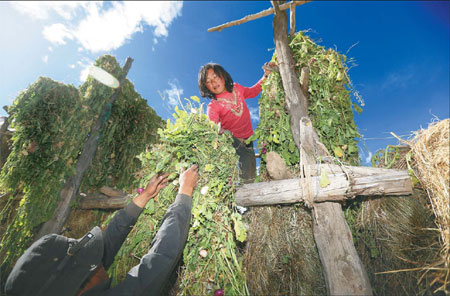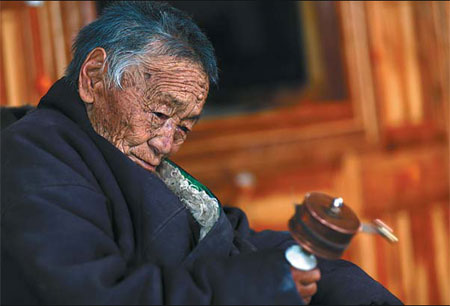

Traditions in decline
But the traditional role of Tibetan women in the herding areas doesn't appeal to Sodnam Yutso. "My dream is to own a small villa on the Qingdao coast and have a career there," she said. Her current job is unrelated to her degree, but she enjoys her public administration work and would like to move to a larger city such as Lhasa one day.
Traditionally, Tibetan women are the family caretakers. During the herding season, they live in the black tents, leaving a strong male family member behind to keep an eye on the house.
 |
|
Villagers prepare fodder for their yaks in Lhashi township of Nagqu prefecture in the Tibet autonomous region. Cui Meng / China Daily |
Birth rates are high and some women even fall pregnant in their 40s. In remote villages, inaccessible by roads and lacking electricity or running water, people live in large households, raising many children to provide extra help with the herding.
However, some of the younger women want to distance themselves from the traditional lifestyle. Accustomed to the outside world, they are more interested in wearing makeup and fashionable clothes.
Tradition and modernity blend well in Rinchen's family in Lhashi township's No 13 village. The 63-year-old veterinarian and his wife Sodnam Yanggrid, 66, have nine children.
Their third son Pundrub, 32, works for the village committee. He has traveled extensively and is married to a woman from Sog county. Unlike other family members who wear traditional robes, Pundrub dresses in a shirt, jacket and trousers. The father of three sons and a daughter, he and his wife have forsworn having more children.
Sodnam Dargyas, Pundrub's 26-year-old brother, earns his money driving the family truck. With his wife, Lhamo Dargyid, he has three sons, the youngest aged 19 months. The couple are the family's caterpillar fungus collectors, but made only 30,000 yuan this year.
Lhamo Dargyid diligently performed the typical Tibetan hospitality rituals, lowering her head like a shy bride and constantly refilling the guests' cups, urging them to take more hot butter tea and yogurt.
Bon versus Buddhism
Begar, the family's 106-year-old grandmother, was 20 years her husband's senior, but she lost him and one of their sons to illness in 2006. Her longevity is the result of her diet, including vegetables and fruits to which Tibetan herders are unaccustomed. Red meat, such as yak and mutton, are the daily fare in herding areas, leading to soaring rates of high blood pressure and high levels of blood fats.
 |
|
At 106 years young, Begar enjoys a moment of serenity with a prayer wheel at her home in Baqen county, the Tibet autonomous region. She credits her longevity to a diet of vegetables and fruit. Cui Meng / China Daily |
Her diminishing faculties mean that during her waking hours Begar likes to keep warm by sitting by the cattle-dung-fuelled oven. Her head droops because she is too frail to hold it upright.
Begar's low-murmured prayers immerse the room in echoes of spiritual reassurance. Her hand turns a Tibetan prayer wheel counterclockwise, as is the practice with Bonpos, followers of the Bon religion, Tibet's indigenous faith before the introduction of Buddhism in the seventh century.
Followers of Tibetan Buddhism spin their prayer wheels clockwise and circle the holy mountains in the same direction.
The Bon religion originated in Zhang Zhung, an ancient kingdom in western Tibet that predated the Buddhist culture and later was conquered by Songtsen Gampo, the first Tubo king.
Fierce rivalry and cultural crossovers developed between the religions and while Buddhism won imperial patronage, Bon declined. At the time, Tibet was depicted as a female demon lying on her back and the locations of Buddhist temples were carefully chosen according to the principles of acupuncture and then applied to the body of the demon to contain her power.
Bon and Buddhism have many features in common, including the use of silk paintings, called Thangkas, prayer flags and wheels, meditation, the tradition of debate, and the emphasis on monastic life as a means of achieving enlightenment.
Buddhism was not only in competition with Bon, but also Catholicism. The powerful Guge Kingdom was founded in the 10th century in western Tibet by Jide Nyimagon, the great-grandson of the last Tubo monarch, Lang Dharma.
The religion flourished for centuries, but in 1624, the Jesuit missionary Antonio de Andrade arrived in the kingdom. The Portuguese priest built a chapel, baptized a handful of people and won the favor of the king, who allowed the suppression of Buddhism. In 1630, the pro-Catholic king, opposed by Buddhist monks and political elites, including his own brother, surrendered to civil revolt and foreign attacks. The chapel was destroyed, but the remains of the legendary kingdom are extant, fascinating archeologists and tourists alike.
Bon continues to flourish in northern and western Tibet, and Nagqu prefecture's Baqen county practices the religion.
The gyungdrung, or swastika, is Bon's primary symbol. It represents eternity, universal harmony and the balance of opposites. The symbol is often seen on the front of large trucks, together with khata, or silk scarves, giving the vehicles an amiable appearance in the face of constant change as they carry modern resources and ancient traditions forward together.
Contact the author at liyao@chinadaily.com.cn